”Hubert Eaton was the founder of Forest Lawn Memorial Parks in Southern California. In fact, Eaton was responsible for revolutionizing the funeral industry. He established what is now known as the “memorial park,” which just means that the gravestones are uniformly flush with the ground, to give it a more “park like” feel. He thought it made it less depressing than regular bone-yards (it also cuts down on lawn mowing expenses). The “pre-need” program was another innovation. People could make their own funeral arrangements before they became necessary – basically meaning, “buy now, pay later.”…
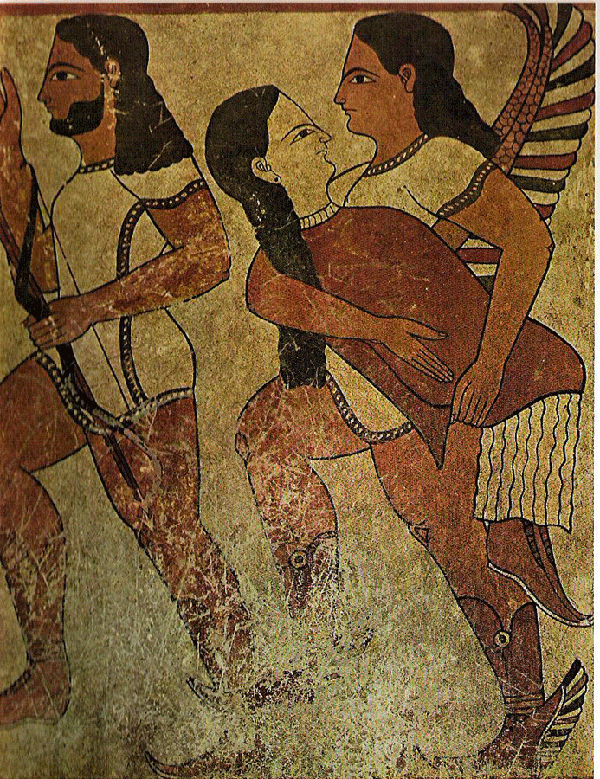
Etruscan Mural. ''Tombs of the wealthy also featured stone figures and objects crafted to recreate all aspects of funeral rituals. Realistic figures of the Gods, the recently deceased, mourners from the community, and surviving family members were carved as if they were seated around a large banquet table, symbolizing the continued relationship that the living, the deceased, and the divine shared after death. Tombs shared by elderly husbands and wives often included sculptures of them embracing, dining, or engaged in discussion, their aged faces etched with lines.''
Everyone in the back of their mind, would like to think of scheme that could cheat death. After Eaton’s Forest Lawn and all its imitators, one turns almost with relief, to the harsh fifteenth-century representations of the dance of death; livid corpses, jangling bones, and skulls that haunt. How wholesome, after Hubert Eaton, seem the savage depictions by Bonfigli of the ravages of plague, or even the nightmares of death painted by Hieronymus Bosch. Even more salutary to turn to the creaming dissolving bodies of a Francis Bacon painting, for surely this is how life ends for most of us, in pain, in agony.
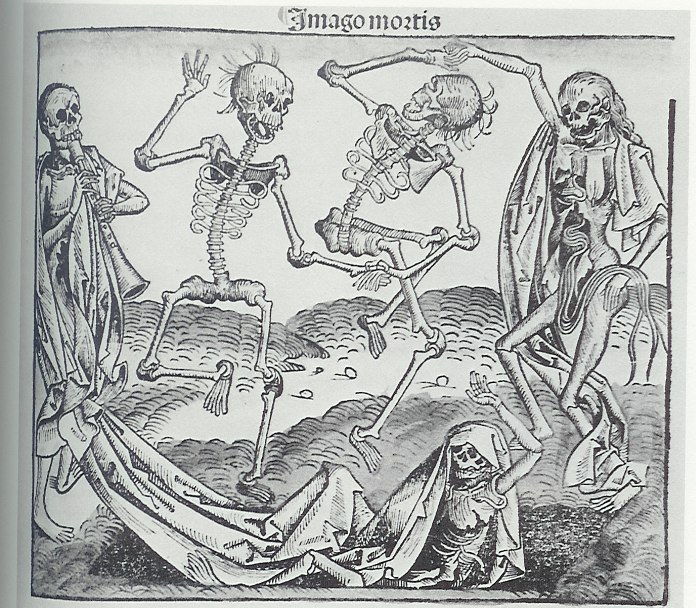
''The Dance of Death can be described as a unique and recognizable reminder that life is brief, and nobody is granted immortality. The alliterative and dramatic name has captured imaginations for centuries and is found in many media. Its heart, however, lies in illustrated books, where the classic Dance of Death format shows people from all ranks of society, beginning with the highest and progressing to the lowest, serially encountering death, represented by a skeleton. While many artists have created their own version of the Dance of Death, the most famous, most influential and greatest was the 16th century interpretation by Hans Holbein, the Younger. ''
”Somewhere along the line, someone convinced this guy that he had good taste, and Eaton took it upon himself to invest in art. Sculptures, mosaics, even the “Garden of Mexican Heritage” graces the grounds of all the Forest Lawns. Mostly it’s just crap reproductions. There’s a 25-foot statue of Michaelangelo’s David in Forest Lawn Glendale, whereas Forest Lawn Covina has the “largest religious mosaic in the Western Hemisphere, measuring 172 feet by 35 feet. Only in America. Don’t even get me started on the “Last Supper Window,” in the Great Mausoleum in Glendale. Okay, I will. It’s a huge stained glass replica of DaVinci’s Last Supper. Then they have this horrible presentation of it, complete with unveiling, every half-hour, including the supposedly eerie legend about the “Judas” glass breaking a few times before the completion (dull stupid dull). The only thing good about the window is that it gives us grave hunters a bit of time to have a gander at the famous graves….More Trivia: Hubert Eaton searched for 25 years, and finally found an image of Christ smiling, to go with all the other God awful crap they have in those cemeteries”.
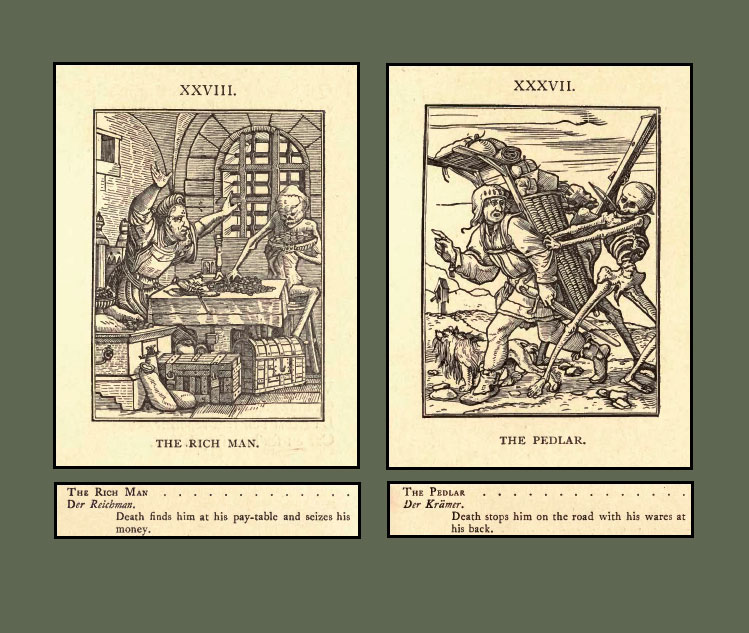
Hans Holbien (1497-1543). In the two images below, death (represented by a skeleton) visits both the rich man and the peddlar alike. Over 100 editions of Holbein's Dance of Death have been published since the original French edition appeared in 1538.
All in all, Hubert Eaton was a modest pioneer of the death industry; for who does not crave to escape oblivion? The rich have always tried to domesticate death, to make death seem like life. The American way of death is not novel. Seen in proper historical perspective it reaches back not only down the centuries but down the millenniums, for it is a response to a deep human need.
Some of the earliest graves of men, dating from paleolithic times, contained corpses decked out with bits of personal finery and sprinkled with red ocher, perhaps the symbol of blood and life, done in the hope of a future resurrection. After the neolithic revolution, which created much greater resources and considerable surplus wealth, men went in for death in a very big way. Doubtless, the poor were thrown away, burned or exposed or pushed into obscurity, back to the anonymous mind from which they came.
The rich and the powerful, high priests and kings, could not die; they merely passed from one life to another. Because the life hereafter was but a mirror image of the life on earth, they took with them everything they needed: jewels, food, furniture, and of course, servants. In the Royal Graves at Ur, some of the earliest and most su
ous of tombs ever found, a row of handmaidens had been slaughtered at the burial; death,s necessities were life’s.No one, of course, carried this elaboration of funerary activity further than the Egyptians. And the tombs of Pharaohs and the high officials of the Egyptian kingdom make Forest Lawn seem like a cheap cemetery for the extreme poor.
Some of the mausoleums outside Washington are stuffed with fine furniture, glassware and jewelry among the embalmed corpses of a Coolidge, a Dulles and others. In a sense, it is vulgar, ridiculous and absurd. However, going back three millenniums, these habits acquire not only decorum but also majesty, grandeur and awe.
The Egyptians were as portentous in death as in life, and their grave goods only occasionally give off the breath of life, unlike the Etruscans, who domesticated death more completely and more joyously than any other society. A rich caste of princes built tombs of singular magnificence , filling them with amphorae , jewels and silver. And they adorned their walls with all the gaiety that they had enjoyed alive. There was nothing solemn about thei attitude to death. In their tombs they hunted, played games, performed acrobatics, danced, feasted; their amorous dalliance was both wanton and guiltless. Deliberately, they banished death with the recollected gusto of life.No society has brought such eroticism , such open and natural behavior, to the charnel house. But in the annals of death, Etruscans are rare birds.
How different the grandoise tombs of medieval barons, with their splendid alabaster or marble effigies. There they lie, larger than life, grave, portentous, frozen in death, a wife, maybe two, rigidly posed beside them, and beneath, sorrowing children, kneeling in filial piety, the whole structure made more pompous with heraldic quarterings.
Yet, these are but another attempt to cheat death, to keep alive in stone what was decaying and crumbling below. And even here a breath of life sometimes creeps in. The Earl and Countess of Arundel lie side by side, dogs beneath the feet, pillows under the head, he in armor, she in her long woolen gown. But, movingly enough, they are holding hands. The sons of Lord Teynham cannot be parted, even in death, with their hawk and hound. Nor were these tombs so cold, so marmoreal, when they were first built. They were painted, the faces as alive with color as the corpses in the parlors of a Forest Lawn.
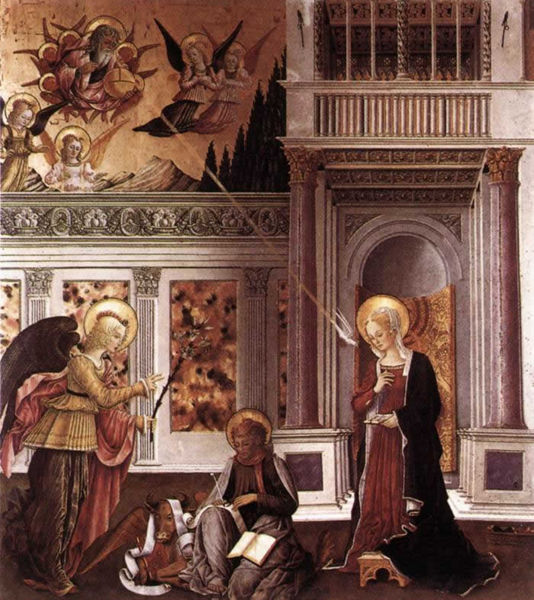
Subject: Annunciation Artist: Benedetto Bonfigli (1425-1496) Date: Late XV century Location: Galleria Nazionale dell'Umbria, Perugia, Italy
Seen in the context of history, pet cemeteries and Forest Lawn style funerals and resting places are neither very remarkable or vulgar. If life has been good, we, like the rich Etruscans, want it to go on and on and on, or at the very least to be remembered. Only a few civilizations have evaded expensive funerary habits for their illustrious rich. For all their austerity, the Hindus, burning bodies and throwing ashes into the Ganges, have maintained distinction in their pyres. Not only were widows coaxed or thrown onto the flames, but rare and perfumed woods were burned to sweeten the spirit of the rich Brahman as it escaped from its corrupt carapace. Cremation a la Chanel!
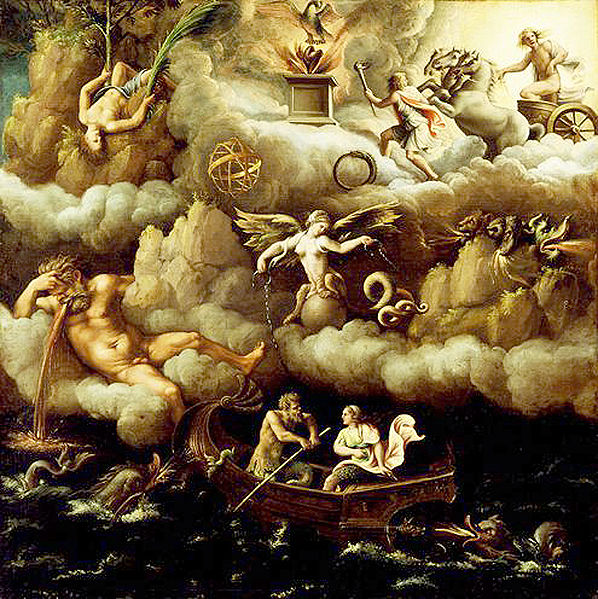
Allegoria dell'immortalità, dipinto di Giulio Romano, 1540 ca, Founders Society Purchase, Mr. and Mrs. Walter Buhl Ford
What is tasteless and vulgar in one age becomes tender and moving in another. What should we say if we decorated our tombs with scenes from football games, nightclubs, and pool hall, or boasted on the side of our coffins of our amatory prowess, as erect as unashamed in death as in life. And yet when the Etruscans do just these things, we are moved to a sense of delight that the force of life could be so strong that men and women reveled in it in their graves.
After all, like those Arundel’s, Eros and Death have gone have gone hand in hand down the ages. The urge to obliterate death is the urge to extend life, and what more natural than that the rich should expect renewal.



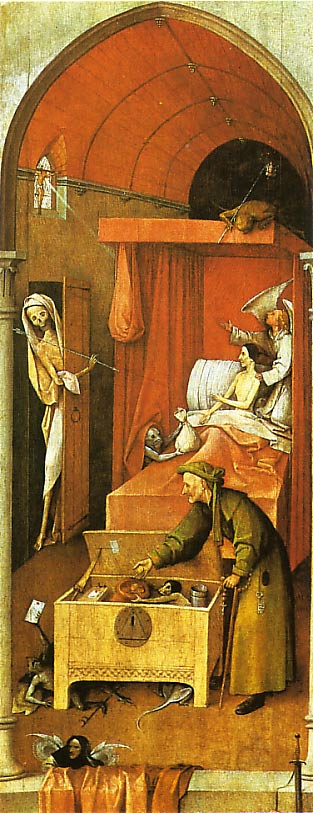
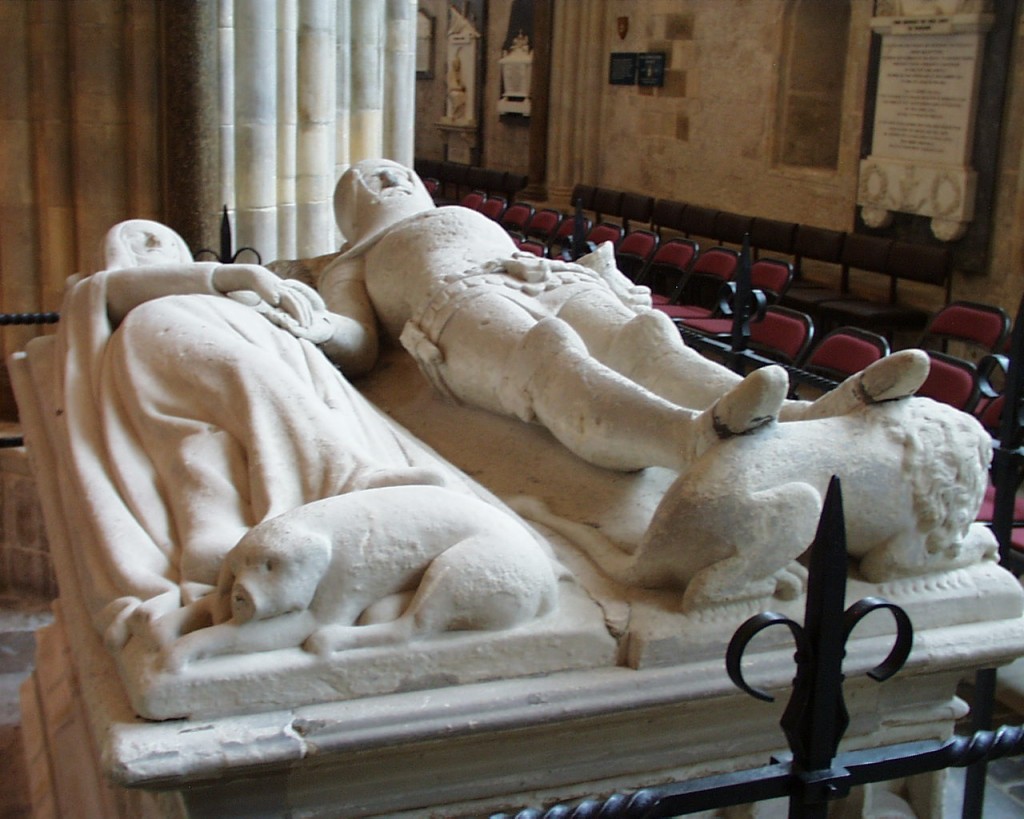

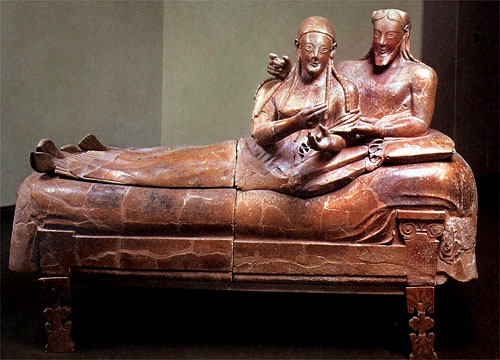
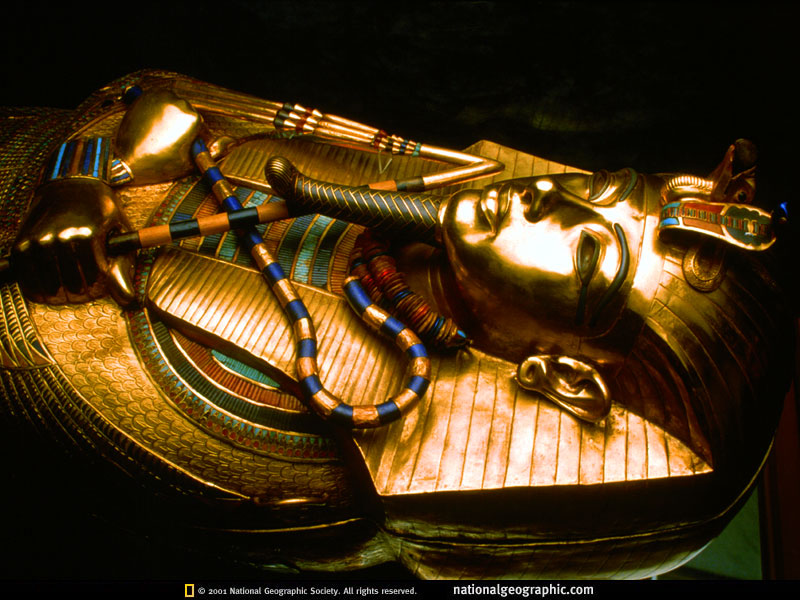




 COMMENTS
COMMENTS



